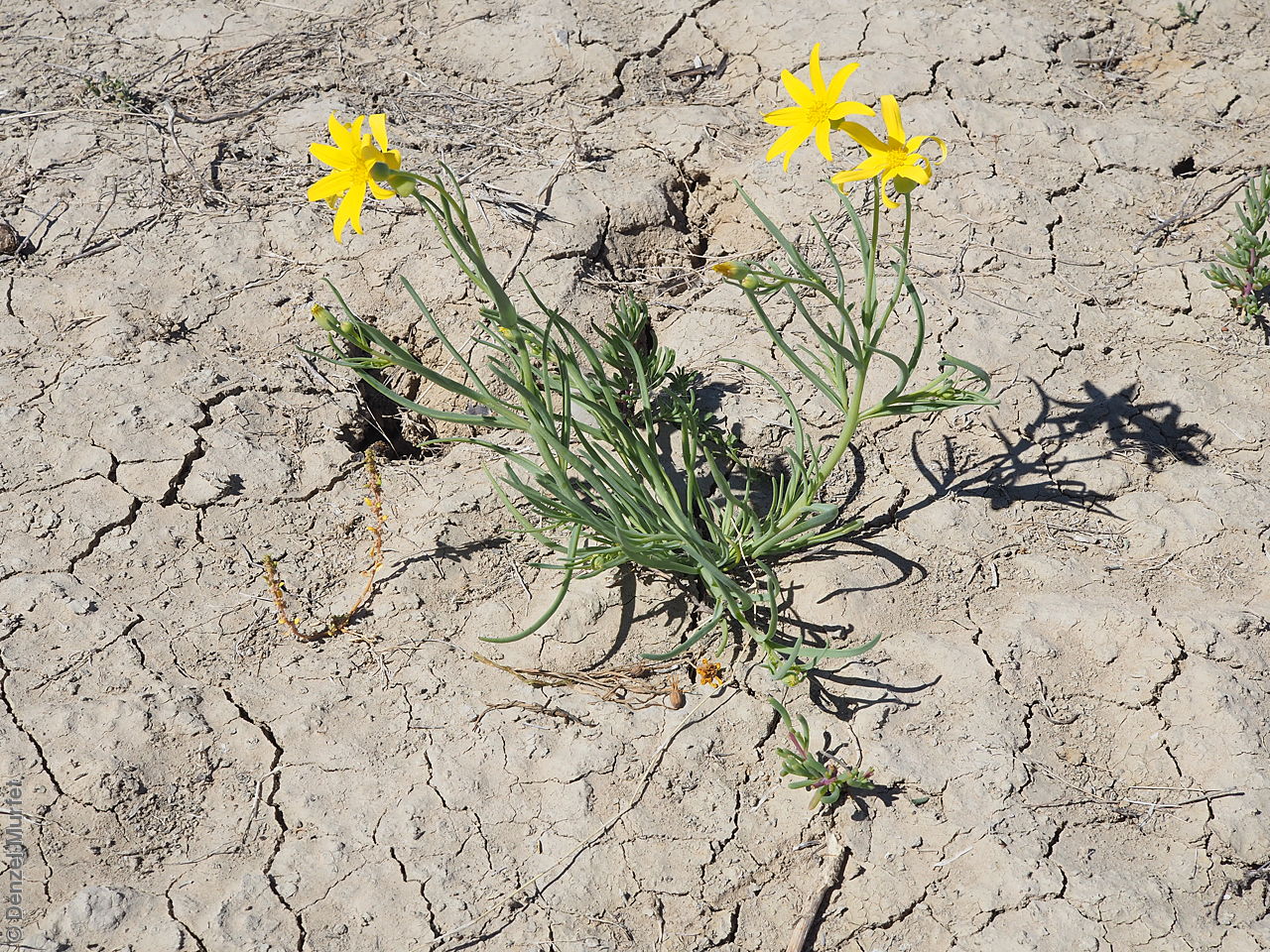Fleshy Groundsel
Display all 15 images















Regional Species Conservation Assessments per IBRA subregion.


Least concern
Near threatened
Rare
Vulnerable
Endangered
Critically endangered
Extinct
Data deficient
Adelaide
Arkaroola
Ceduna
Coober Pedy
Hawker
Innamincka
Marla
Marree
Mount Gambier
Oodnadatta
Renmark
Wudinna
Keith
Yunta
Display IBRA region text
| Olary Spur (FLB03) | Flinders Lofty Block | Data Deficient |
| Northern Flinders (FLB05) | | Least Concern [on sand dunes, widespread] |
| Central Flinders (FLB06) | | Least Concern [on sand dunes, widespread] |
| South Olary Plain (MDD01) | Murray Darling Depression | Data Deficient |
| Murray Mallee (MDD02) | | Data Deficient |
| Myall Plains (GAW01) | Gawler | Rare (IUCN: RA d(ii)) [southern limit] |
| Gawler Volcanics (GAW02) | | Rare (IUCN: RA d(ii)) |
| Gawler Lakes (GAW03) | | Least Concern |
| Arcoona Plateau (GAW04) | | Least Concern |
| Kingoonya (GAW05) | | Least Concern |
| Torrens (GAW06) | | Least Concern [on sand dunes, widespread] |
| Roxby (GAW07) | | Least Concern [on sand dunes, widespread] |
| Commonwealth Hill (GAW08) | | Least Concern [on sand dunes, widespread] |
| Maralinga (GVD03) | Great Victoria Desert | Least Concern |
| Kintore (GVD04) | | Least Concern [on sand dunes, widespread] |
| Tallaringa (GVD05) | | Least Concern [on sand dunes, widespread] |
| Yellabinna (GVD06) | | Least Concern |
| Nullarbor Plain (NUL02) | Nullarbor | Rare (IUCN: RA d(i,ii)) |
| Barrier Range Outwash (BHC04) | Broken Hill Complex | Data Deficient |
| Curnamona (BHC06) | | Data Deficient |
| Simpson Desert (SSD02) | Simpson Strzelecki Dunefields | Least Concern [on sand dunes, widespread] |
| Dieri (SSD03) | | Least Concern [on sand dunes, widespread] |
| Warriner (SSD04) | | Least Concern [on sand dunes, widespread] |
| Strzelecki Desert (SSD05) | | Least Concern [on sand dunes, widespread] |
| Breakaways (STP01) | Stony Plains | Least Concern [on sand dunes, widespread] |
| Oodnadatta (STP02) | | Least Concern [on sand dunes, widespread] |
| Murnpeowie (STP03) | | Least Concern [on sand dunes, widespread] |
| Peake-Dennison Inlier (STP04) | | Least Concern [on sand dunes, widespread] |
| Macumba (STP05) | | Least Concern [on sand dunes, widespread] |
| Witjira (STP06) | | Least Concern [on sand dunes, widespread] |
| Baltana (STP07) | | Least Concern [on sand dunes, widespread] |
| Sturt Stony Desert (CHC02) | Channel Country | Least Concern [on sand dunes, widespread] |
| Diamantina-Eyre (CHC04) | | Least Concern [on sand dunes, widespread] |
| Coongie (CHC06) | | Least Concern [on sand dunes, widespread] |
| Lake Pure (CHC07) | | Least Concern [on sand dunes, widespread] |
| Mann-Musgrave Block (CER01) | Central Ranges | Least Concern [on sand dunes, widespread] |
| Watarru (CER02) | | Least Concern [on sand dunes, widespread] |
| Everard Block (CER03) | | Least Concern [on sand dunes, widespread] |
| Tieyon (FIN03) | Finke | Least Concern [on sand dunes, widespread] |
| Pedirka (FIN04) | | Least Concern [on sand dunes, widespread] |
| 3 of 6 subregions | Flinders Lofty Block | Least Concern , Data Deficient |
| 2 of 6 subregions | Murray Darling Depression | Data Deficient |
| 8 of 8 subregions | Gawler | Least Concern , Rare |
| 4 of 4 subregions | Great Victoria Desert | Least Concern |
| Nullarbor Plain (NUL02) | Nullarbor | Rare (IUCN: RA d(i,ii)) |
| 2 of 4 subregions | Broken Hill Complex | Data Deficient |
| 4 of 4 subregions | Simpson Strzelecki Dunefields | Least Concern |
| 7 of 7 subregions | Stony Plains | Least Concern |
| 4 of 4 subregions | Channel Country | Least Concern |
| 3 of 3 subregions | Central Ranges | Least Concern |
| 2 of 2 subregions | Finke | Least Concern |
Botanical art
Kath Alcock paintings: 3
Prior names
Othonna gregorii
Common names
Fleshy Groundsel
Etymology
Senecio from the Latin 'senex' meaning an old man; referring to the white pappus attached to the seed. Gregorii named after Sir Augustus Charles Gregory (1819-1905), an English-born Australian explorer and surveyor-general and collecter of the type specimen from Coopers Creek.
Distribution and status
found in the northern part of South Australia, growing in a variety of soils in river beds, plains, dunes and margin of saline swamps, in herbfield, shrubland and woodland. Also found in all mainland states. Native. Common in South Australia. Rare in Victoria. Common in the other states.
Herbarium regions: North Western, Lake Eyre, Nullarbor, Gairdner-Torrens, Flinders Ranges, Eastern, Eyre Peninsula, Murray
AVH map: SA distribution map (external link)
Plant description
Glaucous, annual herb to 50 cm high. Stem leaves narrow-linear to 10 cm long, undivided, base narrow. Inflorescence 1-5 on a stem with large yellow daisy-flowers. Flowering between July to December but possibly throughout the year depending on rainfall. Fruits are large daisy-head with exposed yellowish pappus. Seed embryo type is spatulate fully developed.
Seed collection and propagation
Collect seeds between January and December. Collect heads that are large and fluffy. Either pick off the whole heads or use your finger and pull off the seeds from the head. Mature seeds will come off easily. Place the heads in a tray for a week to dry. No cleaning is required if only pure seeds are collected. If heads are collected, then rub the heads gently with your hands to dislodge the seeds. Viable seeds will be fat and hard. Store the seeds with a desiccant such as dried silica beads or dry rice, in an air tight container in a cool and dry place.
















